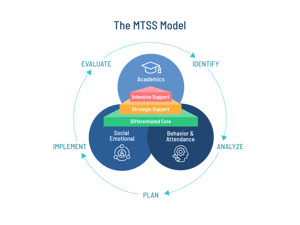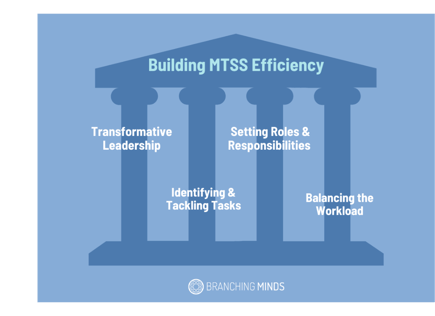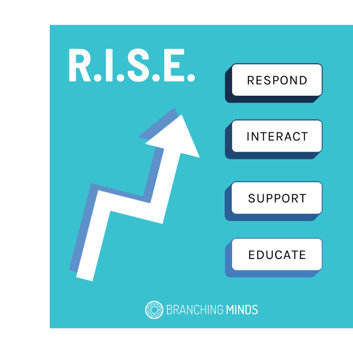As administrators and educational leaders, our intention is always to create and carry out well-developed goals for the upcoming year. We don’t just want to provide opportunities for our staff; we want to engage them, support them, and challenge them while still focusing on objectivity and accountability.
How often do we start the school year with all the intentions of establishing a strong foundation for success, only to become steered off course by day-to-day challenges? These challenges can get the best of us, but they don’t have to interfere with building efficiency with MTSS. When implemented correctly, MTSS encompasses a wide range of collaborative systems of support built to benefit all members of a school community academically, socially and emotionally, and behaviorally.

How do we do this? Well, first, we need to be efficient when planning and ensure that we inspire staff, create a solid action plan, and place value on support and encouragement alongside accountability. We can focus our attention on the four pillars of building MTSS efficiency.
- Transformational leadership
- Identifying and tackling tasks
- Setting roles and responsibilities
- Balancing the workload
When implemented correctly, these pillars will keep all stakeholders successful and supported. And more importantly, it will benefit our most valued population—our students.
Don’t Just Build, Transform Through Transformational Leadership 
James V. Downton coined the term transformational leadership. Transformational leaders don’t just motivate and lead but transform their staff to want to be better. This model of leadership fosters an environment where supportive rapport and clear expectations are well-established. In this type of space, people strive to reach common goals while also setting personal ones.
We’ve all experienced a variety of leaders throughout our lives, having varying expectations for motivating others, encouragement, support, and transparency. Transformational leadership involves a high level of respect where members have autonomy in decision-making. There is support and encouragement. There is a mutual understanding that each member is valued, heard, and respected. This ultimately creates results where “performance exceeds organizational expectations.” Transformational leadership is exactly what is needed to build MTSS efficiency.
Working with an MTSS model means asking team members to adjust their typical routines and establish more proficient protocols that will serve the greater good. And transformational leaders will have a better chance of getting that to happen through the motivating, encouraging, supportive, and transparent environment they create.
|
The Team |
The Tasks |
|
|
➡️ CHECK OUT THIS ON-DEMAND WEBINAR: How to Create an MTSS Team to Guide Your MTSS Practice
Making the shift toward a more efficient MTSS will better support the staff AND the students you serve. This shift is complex and requires people to be vulnerable to new accountability. Having a transformational leader at the forefront will help to empower all team members to make changes for the greater good. Members will feel supported and confident that they have the resources, guidance, support, and communication they need to build MTSS efficiency.
When gearing up to build a successful and efficient year with MTSS, adopting the characteristics of a transformational leader will help you make sure you don’t just lead, but transform your staff into a team of ALL STARS.
So, how do we plan for this kind of shift? Well, you need to R.I.S.E. up as a leader. 
-
The first thing is to create a culture where fostering each other’s strengths and areas of expertise are valued. Think about how you respond to others.
-
All team members need to know that they are appreciated and that their insight and opinions will be heard. This means listening to their concerns and taking an approach that utilizes open lines of communication when interacting and problem-solving.
-
As leaders, we support others to problem solve. We listen, provide guidance, and help staff build, implement, and evaluate plans.
-
Finally, we share the wealth of knowledge that we have and help educate those around us to follow best practices and let the data drive their instruction. Lead by example. Look for opportunities to share research–both theoretical and practical. Share stories of other team members who have had success and use that to help others make similar contributions.
What MTSS Tasks Need To Be Tackled?
Implementing and building a multi-tiered system of supports can be challenging. Our team at Branching Minds has identified some of the most challenging aspects of building MTSS efficiency.
The following are the top 4 challenges to anticipate when implementing an efficient MTSS:
TASK #1: Checking Core Practices for Fidelity and Differentiated Instruction
Tier 1 instruction must be differentiated to meet our learner's specific and diverse needs within an MTSS. Improving the quality of Tier 1 Instruction will ultimately ensure that we are meeting at least 80% of our learner's needs with Tier 1 instruction alone; thus having the resources leftover to support the small percentage of students with targeted and intensive intervention.
While we have curriculum and content material adopted by our districts, we may have different levels of expertise with implementation, lack access to more diverse support resources, or lack content or application knowledge with the material. These challenges can prevent teachers from implementing the curriculum with fidelity.
Leaders can support staff by ensuring the roadblocks are limited. They may consider additional opportunities for professional development. When time is a valuable resource, consider creative alternatives to traditional professional development: consider hosting a voluntary “lunch and learn'' session! Asking educators what they need is the best way to support them! Our collective goal is to ensure our Tier 1 Instruction is diverse, differentiated, and supports our learners.
|
TIP: Remember, when surveying teachers, ensure them that this is not a “gotcha” moment. |
Always remember that encouraging transparency may reveal that there are more people than you anticipated who are not “doing what you expected.” The goal here is to support our educators in building MTSS efficiency. We need our team members to feel safe sharing the truth in hopes of getting the support they need. Ultimately this will benefit your staff, your students, and yourself.
Related Resources:
➡️ GUIDE: MTSS Guide to Core Instruction
➡️ BLOG: The Differentiation Deal: Making a Case for Differentiation in the Classroom
TASK #2: Creating New MTSS Processes/Meetings for Collaboration and Efficiency
Prior to meeting with your team members at the beginning of the year, an efficient MTSS model needs organization. Create a scope and sequence for meetings and check-ins. We encourage setting up three standing meeting structures that support your core health, grade-level problem solving, and individual problem-solving.
|
School Level Meetings |
These meetings are facilitated by leadership and can be held three times a year after each benchmark screening period. The leadership team should use these meetings to discuss the evaluation of tier movement and growth. |
|
Grade/Content Team MTSS Meetings |
These meetings are facilitated by grade level/content level teams and can be held monthly to create intervention group plans, identify patterns of need within the grade and/or content area, and monitor student progress. |
|
Individual Problem-Solving MTSS Meetings |
These meetings are facilitated by assigned teachers and can be held weekly or biweekly (depending upon number of students with needs) and used to create and evaluate plans for individual students. |
➡️ Related Resource: 5 Questions to Ensure Efficiency with MTSS Teams & MTSS Meetings
Leaders can establish set meeting times, agendas/expectations, and determine roles and responsibilities ahead of time. This eliminates unnecessary time in meetings reviewing data and problem admiring. Coming prepared to meetings ensures that the team is able to identify and analyze the problem, develop a plan with a goal, and prepare to implement that plan. Transparency must be at the core of the meetings so the real issues can be discussed.
TASK#3: Finding and Implementing Effective Student Interventions As Well As Tracking Progress
We want to make sure that we are serving and supporting all students across all tier levels of instruction; no one tier is more important than another. When the system can help everyone at their level, it will work like a well-oiled machine. It’s just like owning a car. If you only focus on the interior, eventually, you’ll run out of gas.
So what does it mean to implement plans and progress monitoring within an efficient MTSS process? Well, while it is important to place trust in your team members, we also need to make sure that students are being supported through an MTSS model with fidelity and accountability.
Ask yourself, how do you know that plans are being created, and progress monitoring is taking place? How do we know that teams are meeting and evaluating plan effectiveness and adjusting plans? What system will we use to track and monitor our fidelity of implementation of instructional and intervention plans?
Once you determine how you will monitor the fidelity, you can use meeting times to analyze who may need additional support in these areas, and as a team offer support, guidance, and suggestions to help team members set professional goals.
TASK #4: Actively Managing the Change Management Process
Another way to prepare for implementing an efficient MTSS is to ensure that team members are comfortable with and aware of programs and available intervention strategies that will support students in their classrooms, decision rules, and changes that have been made to processes. How many emails do we receive a day? I know my inbox has an embarrassing amount of unread emails that I always plan to get to, but don’t always have the chance.
When we leave out a critical component of the complex change management model like providing staff with resources, tools, communication, our vision, or expectations, staff begin to feel emotions like frustration, overwhelmed, angst, and sometimes even sabotage that hinder your work toward an efficient MTSS. Part of transparency is ensuring that we are providing multiple opportunities and avenues to provide clear communication and updates regarding our MTSS implementation.
Set the Roles and Responsibilities
While I have shared the importance of having a transformational leader tackling the tasks at the forefront of implementing an efficient MTSS, there are many other roles on our campus that are equally important when building MTSS efficiency. These roles hold various job duties and tasks as well as names at almost every school district I have visited. It's important to clearly define the roles and responsibilities on your campus or within your district to create efficiency and reduce staff feeling confused about their responsibilities.
.png?width=558&name=BrM%20slides%20template%20elements%20(54).png)
Schools can develop their teams and roles based on their student needs, resources, and staff strengths. One classroom may have the teacher assessing, implementing interventions, and tracking data, while another may have the interventionist taking on that role, and another classroom may have both a teacher and the interventionist working together to support struggling students. Additionally, different tiers may have team members in different roles, and their responsibilities may also vary.
Regardless of who is assigned the role, allowing time for collaboration, setting clear guidance, and promoting accountability are key to ensuring that these roles and responsibilities are correctly carried out. With so many different layers encompassing an MTSS approach, checking in frequently with members in a variety of roles and with a variety of responsibilities is key to making sure there is continuity and accountability.
Remember To Share the Workload
The best leaders know when to lead and when to let others lead. This is also a great strategy to ensure that no one person is doing all the work because that could be overwhelming.
Here are some suggestions to keep in mind to ensure there is balance:
- Foster open lines of communication
- Check the temperature of your team members regularly
- Create and share documents that help facilitate efficiency
- Use discussion protocols to help push thinking forward
- Don’t overload those involved—limit the minutia
- Focus on what’s most important
Recognize patterns and challenges and consider if it is perhaps because someone is carrying more than they can handle. Make sure that no one person is doing it all. MTSS is designed to help share the workload as it is a system for schools. Systems are designed to have multiple parts (or people!) that need to work together to be successful.
Building MTSS efficiency is possible, and it begins at the top. Transformational leaders ensure much more than just tasks are completed; they ensure everyone knows their roles and responsibilities, and that the workload is shared among team members to start this year right, follow the pillars and make necessary changes to support your school and students with MTSS. In the end, everyone will benefit.
Citations
Farnsworth, D., Clark, J. L., Johnson, S., Wysocki, A., & Kepner, K. (2020, October 7). TRANSFORMATIONAL LEADERSHIP: THE TRANSFORMATION OF MANAGERS AND ASSOCIATES. HR020/HR020: Transformational leadership: The transformation of managers and associates. Retrieved July 25, 2022, from https://edis.ifas.ufl.edu/publication/HR020
![[Guest Author] Dr. Jessica Shackil-avatar](https://www.branchingminds.com/hs-fs/hubfs/Team/Round%20cropped%20headshots/jessica-shackil-headshot.png?width=82&height=82&name=jessica-shackil-headshot.png)
About the author
[Guest Author] Dr. Jessica Shackil
Jessica Shackil has over ten years of experience in the elementary classroom. She is certified in general and special education and holds a doctoral degree in K-12 educational leadership. She also works in higher education as an adjunct professor. Jessica is passionate about sharing her educational experiences in her more recent role as an educational consultant. She currently works in several New Jersey districts where she supports teachers and administrators. She strongly believes that all students can be successful and that learning should be fun.

Your MTSS Transformation Starts Here
Enhance your MTSS process. Book a Branching Minds demo today.


















.png?width=716&height=522&name=Qualitative%20data%20MTSS%20(preview).png)
